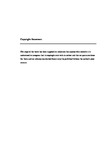THE SOURCES AND FATE OF PLASTIC ENTERING THE MARINE ENVIRONMENT
| dc.contributor.supervisor | Thompson, Richard | |
| dc.contributor.author | Napper, Imogen Ellen | |
| dc.contributor.other | School of Biological and Marine Sciences | en_US |
| dc.date.accessioned | 2019-07-31T10:53:57Z | |
| dc.date.issued | 2019 | |
| dc.identifier | 10511016 | en_US |
| dc.identifier.uri | http://hdl.handle.net/10026.1/14729 | |
| dc.description.abstract |
Plastics can come in many forms and bring a wide range of societal benefits in healthcare, agriculture, transport, construction and packaging. However, plastic is a large proportion of marine litter and an internationally recognised pollutant. Marine litter results from the indiscriminate disposal of waste items that are either directly or indirectly transferred into aquatic environments. This debris can cause harmful effects for wildlife, commercial fisheries, maritime industries, tourism and human well-being (Chapter 1). Over the past decade, increased scientific interest has produced an expanding knowledge base for plastic contamination in the environment. However, fundamental questions and issues remain unresolved. This thesis addresses several prominent sources of plastic litter and discusses the routes by which the plastic can enter the environment; these include facial scrubs, laundering clothes, wet wipes and carrier bags. Whilst the emphasis of this thesis is on microplastics (both primary and secondary source), the indiscriminate disposal of macroplastics are also considered, as, with time, they have the potential to degrade into secondary microplastics. Cosmetic products, such as facial scrubs, were identified as a potentially important primary sources of microplastics to the marine environment. Up to 94500 microplastics were found to release in a single use (Chapter 2). The laundering clothes was also found to be an important source of primary microplastic where over 700,000 fibres were estimated to be released from an average 6 kg wash load (Chapter 3). Wet wipes degradability was tested for both flushable and non-flushable alternatives. There are currently no standardised criteria to measure whether a product can be flushed, and the degradability of these products still remains unclear (Chapter 4). Furthermore, different formulations of carrier bags that stated that they were biodegradable and oxo-biodegradable, were still present in the soil and marine environment after 3 years. This suggests that they have no meaningful advantage over conventional bags in terms of consequences of persistence. (Chapter 5). The versatility, low cost and often single use application of plastic mean that the material is utilised for a wide variety of products. Therefore, one of the major challenges in addressing the issues surrounding marine plastic debris is the diverse nature of plastic products and the many routes by which they can enter the environment. To help manage and reduce emissions it is essential to better understand the relative importance of these sources, assess regional variation and target specific solution options (Chapter 6). | en_US |
| dc.language.iso | en | |
| dc.publisher | University of Plymouth | |
| dc.rights | CC0 1.0 Universal | * |
| dc.rights.uri | http://creativecommons.org/publicdomain/zero/1.0/ | * |
| dc.subject | Plastic | en_US |
| dc.subject | Microplastic | en_US |
| dc.subject.classification | PhD | en_US |
| dc.title | THE SOURCES AND FATE OF PLASTIC ENTERING THE MARINE ENVIRONMENT | en_US |
| dc.type | Thesis | |
| plymouth.version | publishable | en_US |
| dc.identifier.doi | http://dx.doi.org/10.24382/511 | |
| dc.rights.embargodate | 2020-07-31T10:53:57Z | |
| dc.rights.embargoperiod | 12 months | en_US |
| dc.type.qualification | Doctorate | en_US |
| rioxxterms.version | NA |
Files in this item
This item appears in the following Collection(s)
-
01 Research Theses Main Collection
Research Theses Main



